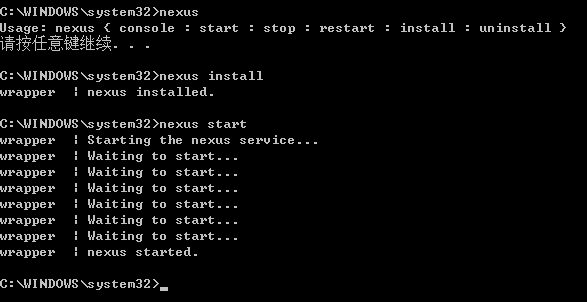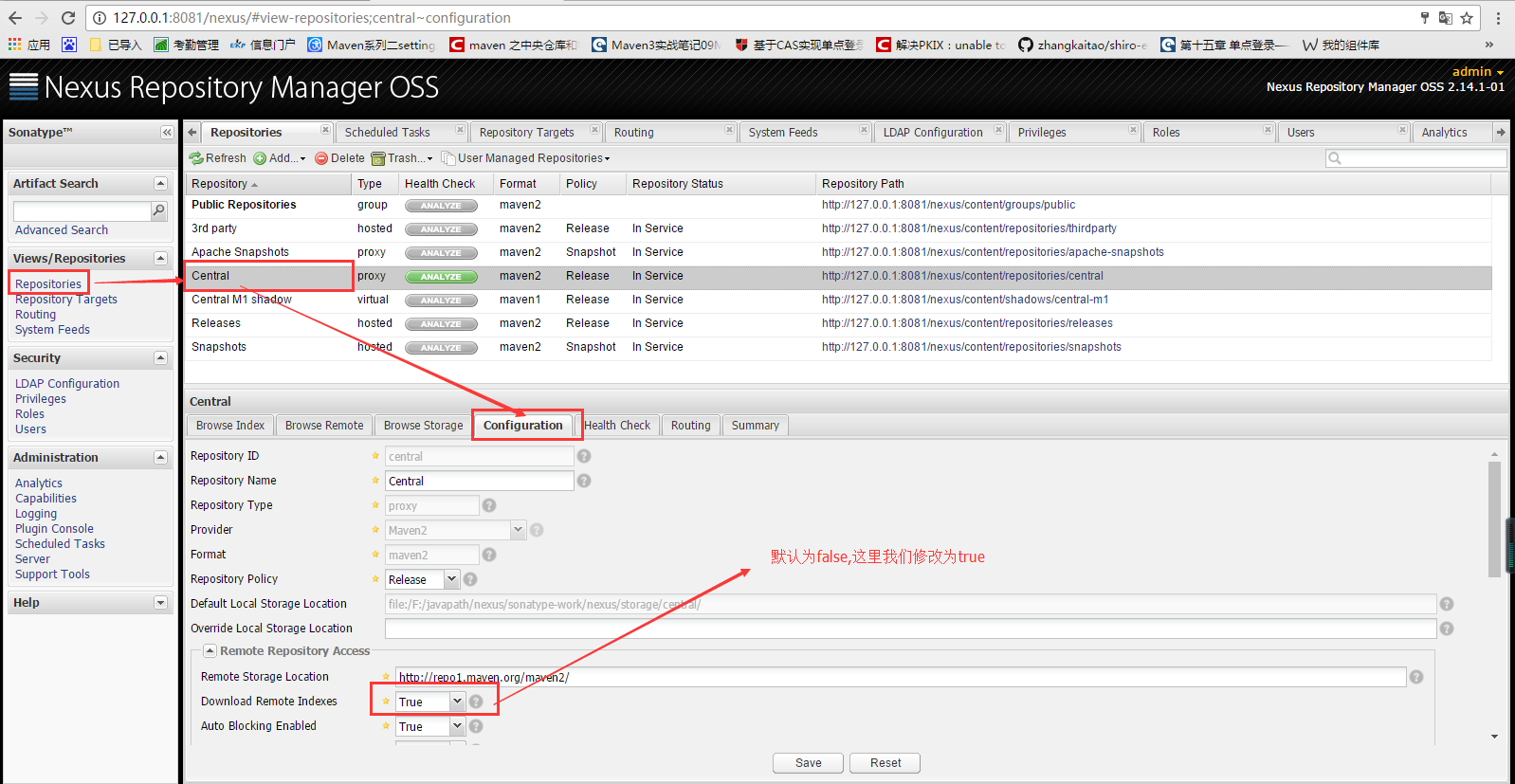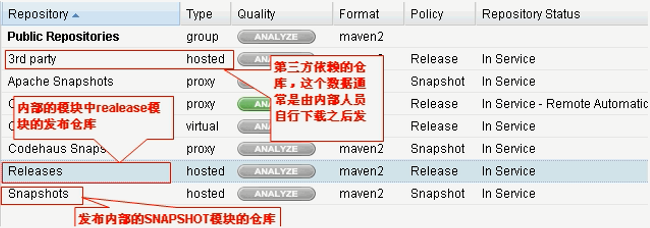Maven私服的简单搭建教程(Nexus)
2016-12-10 00:00
253 查看
摘要: 写个简单的Maven私服的搭建教程,前提是maven入门级,只能凑合自己开发用。
如果不能下载给我私信,最近也一直在想把这些东西方github上,但是想想自己老是看不懂,就。。。

找里面有这样一个属性wrapper.java.command,将其指向当前的jdk。
2、F:\javapath\nexus\nexus-2.14.1-01\conf\nexus.properties
修改配置文件的application-port和application-host,分别指向maven私服的端口号和Ip

nexus install是将nexus安装到本机服务里,nexus start是启动nexus服务,此时如果访问http://127.0.0.1:8081/nexus


则证明nexus初步跑成功了。
Nexus默认管理用户名和密码为admin/admin123。

单击左边导航栏的Repositories,选择Central,点击Configuration,里面有一个Download Remote Indexes配置,默认状态是false,将其改为true,‘Save’后,单击Administration==> Scheduled Tasks, 就有一条更新Index的任务,这个是Nexus开始下载中央仓库的索引。由于中央仓库的内容比较多,因此其索引文件比较大,Nexus下载该文件也需要比较长的时间。上班的时间慎用,实在是太耗硬盘了,我这边实测下载速度能到10M/S,更新一次镜像大概要花掉1个小时左右的时间,硬盘一直是100%,电脑卡死,而且我在第一次更新的时候并没有生成Scheduled Tasks,所以并没有索引和镜像的更新,然后重试了两次才好,尤其是maven私服在本地的时候,pom文件增加依赖是瞬间下载。然后就是更新完一次之后基本上就不用再动了,感觉平常跑这个服务队电脑的配置吃的不大,并没有什么影响,只要不手动更新镜像就好。


中央仓库的地址有很多,可以从网上查到,如果感觉到你用的线路很慢的话可以自己手动更改。
hosted仓库,内部项目的发布仓库。

proxy仓库,从远程中央仓库寻找数据的仓库

group仓库,组仓库方便开发人员进行设置的仓库

将多个Repositories添加到public Repositories,我们直接调用就public Repositories的url作为maven仓库的地址就可以
在pom.xml文件中私服的指定
第一步,下载nexus的安装包并解压
链接:http://pan.baidu.com/s/1jIhpZ98 密码:6bqx如果不能下载给我私信,最近也一直在想把这些东西方github上,但是想想自己老是看不懂,就。。。
第二步,将bin添加到环境变量
F:\javapath\nexus\nexus-2.14.1-01\bin
第三步,修改nexus的配置文件
1、F:\javapath\nexus\nexus-2.14.1-01\bin\jsw\conf\wrapper.conf找里面有这样一个属性wrapper.java.command,将其指向当前的jdk。
wrapper.java.command=F:\javapath\jdk\jdk1.7.0_80\bin\java
2、F:\javapath\nexus\nexus-2.14.1-01\conf\nexus.properties
修改配置文件的application-port和application-host,分别指向maven私服的端口号和Ip
application-port=8081 application-host=127.0.0.1
第四步,nexus服务的安装

nexus install是将nexus安装到本机服务里,nexus start是启动nexus服务,此时如果访问http://127.0.0.1:8081/nexus


则证明nexus初步跑成功了。
Nexus默认管理用户名和密码为admin/admin123。
第五步,nexus索引的更新,这一步就决定了你的maven私服能不能工作了。

单击左边导航栏的Repositories,选择Central,点击Configuration,里面有一个Download Remote Indexes配置,默认状态是false,将其改为true,‘Save’后,单击Administration==> Scheduled Tasks, 就有一条更新Index的任务,这个是Nexus开始下载中央仓库的索引。由于中央仓库的内容比较多,因此其索引文件比较大,Nexus下载该文件也需要比较长的时间。上班的时间慎用,实在是太耗硬盘了,我这边实测下载速度能到10M/S,更新一次镜像大概要花掉1个小时左右的时间,硬盘一直是100%,电脑卡死,而且我在第一次更新的时候并没有生成Scheduled Tasks,所以并没有索引和镜像的更新,然后重试了两次才好,尤其是maven私服在本地的时候,pom文件增加依赖是瞬间下载。然后就是更新完一次之后基本上就不用再动了,感觉平常跑这个服务队电脑的配置吃的不大,并没有什么影响,只要不手动更新镜像就好。


中央仓库的地址有很多,可以从网上查到,如果感觉到你用的线路很慢的话可以自己手动更改。
hosted仓库,内部项目的发布仓库。

proxy仓库,从远程中央仓库寻找数据的仓库

group仓库,组仓库方便开发人员进行设置的仓库

将多个Repositories添加到public Repositories,我们直接调用就public Repositories的url作为maven仓库的地址就可以
第六步,贴出我的Maven的sitting.xml文件
<?xml version="1.0" encoding="UTF-8"?> <!-- Licensed to the Apache Software Foundation (ASF) under one or more contributor license agreements. See the NOTICE file distributed with this work for additional information regarding copyright ownership. The ASF licenses this file to you under the Apache License, Version 2.0 (the "License"); you may not use this file except in compliance with the License. You may obtain a copy of the License at http://www.apache.org/licenses/LICENSE-2.0 Unless required by applicable law or agreed to in writing, software distributed under the License is distributed on an "AS IS" BASIS, WITHOUT WARRANTIES OR CONDITIONS OF ANY KIND, either express or implied. See the License for the specific language governing permissions and limitations under the License. --> <!-- | This is the configuration file for Maven. It can be specified at two levels: | | 1. User Level. This settings.xml file provides configuration for a single user, | and is normally provided in ${user.home}/.m2/settings.xml. | | NOTE: This location can be overridden with the CLI option: | | -s /path/to/user/settings.xml | | 2. Global Level. This settings.xml file provides configuration for all Maven | users on a machine (assuming they're all using the same Maven | installation). It's normally provided in | ${maven.home}/conf/settings.xml. | | NOTE: This location can be overridden with the CLI option: | | -gs /path/to/global/settings.xml | | The sections in this sample file are intended to give you a running start at | getting the most out of your Maven installation. Where appropriate, the default | values (values used when the setting is not specified) are provided. | |--> <settings xmlns="http://maven.apache.org/SETTINGS/1.0.0" xmlns:xsi="http://www.w3.org/2001/XMLSchema-instance" xsi:schemaLocation="http://maven.apache.org/SETTINGS/1.0.0 http://maven.apache.org/xsd/settings-1.0.0.xsd"> <!-- localRepository | The path to the local repository maven will use to store artifacts. | | Default: ${user.home}/.m2/repository <localRepository>/path/to/local/repo</localRepository> --> <localRepository>E:\m2e\Repository</localRepository> <!-- interactiveMode | This will determine whether maven prompts you when it needs input. If set to false, | maven will use a sensible default value, perhaps based on some other setting, for | the parameter in question. | | Default: true <interactiveMode>true</interactiveMode> --> <!-- offline | Determines whether maven should attempt to connect to the network when executing a build. | This will have an effect on artifact downloads, artifact deployment, and others. | | Default: false <offline>false</offline> --> <!-- pluginGroups | This is a list of additional group identifiers that will be searched when resolving plugins by their prefix, i.e. | when invoking a command line like "mvn prefix:goal". Maven will automatically add the group identifiers | "org.apache.maven.plugins" and "org.codehaus.mojo" if these are not already contained in the list. |--> <pluginGroups> <!-- pluginGroup | Specifies a further group identifier to use for plugin lookup. <pluginGroup>com.your.plugins</pluginGroup> --> </pluginGroups> <!-- proxies | This is a list of proxies which can be used on this machine to connect to the network. | Unless otherwise specified (by system property or command-line switch), the first proxy | specification in this list marked as active will be used. |--> <proxies> <!-- proxy | Specification for one proxy, to be used in connecting to the network. | <proxy> <id>optional</id> <active>true</active> <protocol>http</protocol> <username>proxyuser</username> <password>proxypass</password> <host>proxy.host.net</host> <port>80</port> <nonProxyHosts>local.net|some.host.com</nonProxyHosts> </proxy> --> </proxies> <!-- servers | This is a list of authentication profiles, keyed by the server-id used within the system. | Authentication profiles can be used whenever maven must make a connection to a remote server. |--> <servers> <server> <id>releases</id> <username>admin</username> <password>admin123</password> </server> <server> <id>snapshots</id> <username>admin</username> <password>admin123</password> </server> </servers> <!-- mirrors | This is a list of mirrors to be used in downloading artifacts from remote repositories. | | It works like this: a POM may declare a repository to use in resolving certain artifacts. | However, this repository may have problems with heavy traffic at times, so people have mirrored | it to several places. | | That repository definition will have a unique id, so we can create a mirror reference for that | repository, to be used as an alternate download site. The mirror site will be the preferred | server for that repository. |--> <mirrors> <mirror> <id>nexus</id> <mirrorOf>*</mirrorOf> <url>http://127.0.0.1:8081/nexus/content/groups/public</url> </mirror> </mirrors> <!-- profiles | This is a list of profiles which can be activated in a variety of ways, and which can modify | the build process. Profiles provided in the settings.xml are intended to provide local machine- | specific paths and repository locations which allow the build to work in the local environment. | | For example, if you have an integration testing plugin - like cactus - that needs to know where | your Tomcat instance is installed, you can provide a variable here such that the variable is | dereferenced during the build process to configure the cactus plugin. | | As noted above, profiles can be activated in a variety of ways. One way - the activeProfiles | section of this document (settings.xml) - will be discussed later. Another way essentially | relies on the detection of a system property, either matching a particular value for the property, | or merely testing its existence. Profiles can also be activated by JDK version prefix, where a | value of '1.4' might activate a profile when the build is executed on a JDK version of '1.4.2_07'. | Finally, the list of active profiles can be specified directly from the command line. | | NOTE: For profiles defined in the settings.xml, you are restricted to specifying only artifact | repositories, plugin repositories, and free-form properties to be used as configuration | variables for plugins in the POM. | |--> <profiles> <!-- profile | Specifies a set of introductions to the build process, to be activated using one or more of the | mechanisms described above. For inheritance purposes, and to activate profiles via <activatedProfiles/> | or the command line, profiles have to have an ID that is unique. | | An encouraged best practice for profile identification is to use a consistent naming convention | for profiles, such as 'env-dev', 'env-test', 'env-production', 'user-jdcasey', 'user-brett', etc. | This will make it more intuitive to understand what the set of introduced profiles is attempting | to accomplish, particularly when you only have a list of profile id's for debug. | | This profile example uses the JDK version to trigger activation, and provides a JDK-specific repo. <profile> <id>jdk-1.4</id> <activation> <jdk>1.4</jdk> </activation> <repositories> <repository> <id>jdk14</id> <name>Repository for JDK 1.4 builds</name> <url>http://www.myhost.com/maven/jdk14</url> <layout>default</layout> <snapshotPolicy>always</snapshotPolicy> </repository> </repositories> </profile> --> <!-- | Here is another profile, activated by the system property 'target-env' with a value of 'dev', | which provides a specific path to the Tomcat instance. To use this, your plugin configuration | might hypothetically look like: | | ... | <plugin> | <groupId>org.myco.myplugins</groupId> | <artifactId>myplugin</artifactId> | | <configuration> | <tomcatLocation>${tomcatPath}</tomcatLocation> | </configuration> | </plugin> | ... | | NOTE: If you just wanted to inject this configuration whenever someone set 'target-env' to | anything, you could just leave off the <value/> inside the activation-property. | <profile> <id>env-dev</id> <activation> <property> <name>target-env</name> <value>dev</value> </property> </activation> <properties> <tomcatPath>/path/to/tomcat/instance</tomcatPath> </properties> </profile> --> <profile> <id>nexus</id> <repositories> <repository> <id>dp-repo</id> <name>Repository for ane56</name> <url>http://127.0.0.1:8081/nexus</url> <releases> <enabled>true</enabled> </releases> <snapshots> <enabled>true</enabled> <updatePolicy>always</updatePolicy> <checksumPolicy>ignore</checksumPolicy> </snapshots> <layout>default</layout> </repository> <repository> <id>releases</id> <url>http://127.0.0.1:8081/nexus/content/repositories/releases</url> </repository> <repository> <id>central</id> <url>http://central</url> <releases> <enabled>true</enabled> </releases> <snapshots> <enabled>true</enabled> </snapshots> </repository> </repositories> <pluginRepositories> <pluginRepository> <id>central</id> <url>http://central</url> <releases> <enabled>true</enabled> </releases> <snapshots> <enabled>true</enabled> </snapshots> </pluginRepository> </pluginRepositories> </profile> </profiles> <!-- activeProfiles | List of profiles that are active for all builds. | <activeProfiles> <activeProfile>alwaysActiveProfile</activeProfile> <activeProfile>anotherAlwaysActiveProfile</activeProfile> </activeProfiles> --> <activeProfiles> <activeProfile>nexus</activeProfile> </activeProfiles> </settings>
在pom.xml文件中私服的指定
<!-- 指定Maven私服地址 --> <repositories> <repository> <id>portal</id> <url>http://127.0.0.1:8081/nexus/content/groups/public/</url> <releases><enabled>true</enabled></releases> <snapshots><enabled>true</enabled></snapshots> </repository> </repositories>
相关文章推荐
- Linux centeros 6.5 搭建nexus maven私服搭建教程
- centos下 Maven 私服nexus 搭建教程
- maven和私服nexus搭建教程
- 搭建maven nexus私服教程
- Maven教程-使用Nexus搭建私服
- Maven教程-使用Nexus搭建私服
- 使用nexus搭建maven私服教程详解
- maven教程四之使用Nexus搭建Maven私服
- maven 教程四 使用Nexus搭建Maven私服
- 用nexus搭建maven私服
- Linux安装配置maven以及搭建nexus私服
- Maven系列二:利用Nexus搭建私服
- 使用Nexus搭建Maven私服
- 用nexus搭建maven私服(整合网上文章而成的)
- Sonatype Nexus 搭建Maven 私服
- maven的安装及nexus搭建私服
- 用nexus搭建maven私服
- maven--私服的搭建(Nexus的使用)
- 搭建配置私服-nexus ,Maven中的使用——3
- Maven学习 (四) 使用Nexus搭建Maven私服
